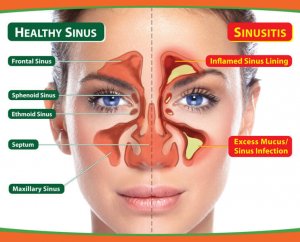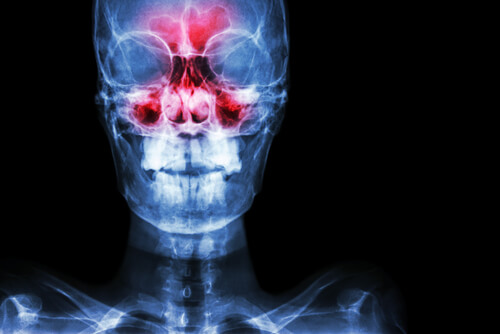Sinusitis Symptoms: From Origin to Diagnosis

Sinusitis is inflammation of the paranasal sinuses. These are two small, hollow spaces through which air passes to circulate between the bones of your nose. There are several sinusitis symptoms to note.
The sinuses are divided into three groups: frontal, ethmoidal, and sphenoid and maxillary sinuses.
When everything is normal, the air moves freely through these cavities.
However, when the sinuses become inflamed, breathing gets more difficult and other sinusitis symptoms can arise, such as pain that can be very intense.
If your sinuses are healthy, there is no presence of bacteria or other organisms. In this case, mucus can flow in or out of your nose without a problem. When too much mucus builds up or there is a blockage of the paranasal openings, a breeding ground is created for various types of microorganisms. This can wind up causing sinusitis.
The origins of sinusitis
Too much mucus or a blockage of your paranasal openings can be caused by a variety of factors that lead to sinusitis symptoms. The most common ones are the following:
- Allergies and colds, which contribute to the production of high volumes of mucus
- Abnormal bone protrusions in the nose
- Deviated septum
- The presence of nasal polyps
- The condition of the cilia (hairs located in the paranasal openings), if they aren’t able to remove mucus

Sinusitis symptoms and types
Also, there are several types of sinusitis that can differ depending on how long they last. In total, four basic classes can be identified:
- Acute: lasts up to four weeks
- Subacute: lasts four to 12 weeks
- Chronic: lasts more than 12 weeks
- Recurrent: several attacks occurring within the same year
There are certain symptoms that are common to all types of sinusitis. The most important ones are:
- Loss of smell or bad breath
- Coughing, which is more intense at night
- Fatigue
- Pain
- Headache
- Pressure in the area around the nose
- Pain behind the eyes
- Toothaches
- Facial sensitivity
- Nasal congestion
- Runny nose
- Sore throat
With acute sinusitis, the symptoms appear around a week after having caught a cold. And, for chronic sinusitis, the sinusitis symptoms are similar. However, they tend to be milder and last for a longer period of time.
Diagnosing the disease
Typically, a diagnosis is made based on a nasal exam. The doctor will shine a light in the area, looking for polyps or any signs of inflammation. It’s common to apply pressure on the area to check for the presence of pain. Pain can usually indicate whether it’s sinusitis or not.

Additionally, a doctor can also order other complementary tests, including: nasal cultures, cytology testing, blood tests to evaluate the health of your immune system, and tests for allergies, ciliary function, or cystic fibrosis.
Prognosis and complications
When sinusitis is treated early, the prognosis is generally very favorable. What’s more, if the proper treatment is obtained and the necessary care is maintained, a patient typically fully recovers. If there are recurrent episodes, it’s a sign that the cause of the disease hasn’t been correctly treated.
Complications of sinusitis are not frequent. However, if they occur, they must be taken very seriously. The most frequent complications are:
- Asthma, derived from chronic sinusitis
- Difficulties with the vision that can originate when an infection spreads to the eye, leading to loss of vision or even blindness
- Blood clots or aneurisms. Sinusitis can affect the veins around your sinuses. In these cases, blood flow is interrupted and you risk suffering from a stroke.
- This can occur when inflammation advances around or near your brain
Additionally, Other less common complications are bone infections (osteomyelitis) and cutaneous infections in the area around the eyes. Any complications should be treated as soon as possible at a health facility.
All cited sources were thoroughly reviewed by our team to ensure their quality, reliability, currency, and validity. The bibliography of this article was considered reliable and of academic or scientific accuracy.
- Brook, I. (2011). Microbiology of Sinusitis. Proceedings of the American Thoracic Society. https://doi.org/10.1513/pats.201006-038RN
- Kaur R, Adlowitz DG, Casey JR, Zeng M, Pichichero ME. Simultaneous assay for four
bacterial species including Alloiococcus otitidis using multiplex-PCR in children with
culture negative acute otitis media. Pediatr Infect Dis J 2010; 29:741–5 - Meltzer EO, Hamilos DL, Hadley JA, Lanza DC, Marple BF, Nicklas RA, et al. Rhinosinusitis: developing guidance for clinical trials. J Allergy Clin Immunol. 2006; 118 (5 Suppl): S17-61.
- Jacobs MR, Felmingham D, Appelbaum PC, et al. The Alexander Project 1998- 2010: susceptibility of pathogens isolated from communityacquired respiratory tract infection to commonly used antimicrobial
agents. J Antimicrob Chemother. 2013; 52: 229-46.
This text is provided for informational purposes only and does not replace consultation with a professional. If in doubt, consult your specialist.








